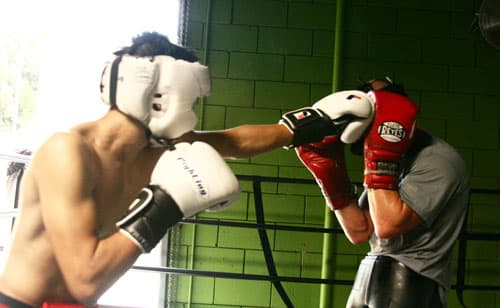
Everyone knows how to punch hard, but what about how to punch light?
- Light punches are faster, require less energy, and leave you less vulnerable.
- Light punches can confuse your opponent’s defense and for more unpredictable attacks.
- Light punches can be thrown from a wider range of positions than harder punches.
Learning how to use light punches can actually make you a HARDER AND MORE EFFECTIVE PUNCHER!
Why Use Light Punches?
In all honesty, this guide is about getting you to throw lighter punches. Everyone already knows how to throw hard punches. It’s probably all you’ve ever dreamed about since watching your first Mike Tyson highlight on youtube. I would guess that 90% of every beginner boxer’s practice on the bag was focused on “hard” punches.
But now we’re going to focus on the exact opposite, which is light punches. You’ll learn not only HOW to punch lighter but more importantly, HOW TO WIN with lighter punches. I don’t want you to get out-punched because you threw pitty-pat punches while your opponent threw knockout blows. I want you to confuse his defenses, throw off his rhythm using your light punches…which then sets him up for your hard punches.
Ok, why use light punches? We all know light punches aren’t going to hurt anybody.
REASON #1 – Light punches can set up opponents for the harder punches
Light punches are faster and more versatile. You need that speed to surprise and pry open your opponent’s defense for the bigger punches. This is why the jab is the most important weapon. Instead of trying to set power punches up with a power jab or another power punch, try using a fast jab to get the first shot which then buys time for your slower (but more powerful) punches.
It’s not only a matter of speed but also a matter of positioning and timing. Sometimes, it takes a few shots to get your opponent right where you want him in the right place at the right time for your power shot. Nobody is going to walk around vulnerable and it takes a few punches to get him to open up. In situations like this, you need some setup punches to do all the work before you can get the power punches in. And it’s best to use the lighter faster shots because they require less energy and don’t leave you as vulnerable to counters.
REASON #2 – Light punches can be used from a wider range of positions and moments
Unlike power punches, light punches can be thrown from almost any position. You don’t need to be perfectly balanced or grounded the same way you would for a power punch. You don’t need to be in the perfect position or rotate for power. As long as you can stick an arm out, you can use a light punch.
By not being limited by a position that allows for power, you can threaten and surprise opponents with light punches in any situation.
Advantage of Light Punches:
1. Faster and more versatile, using less energy and leaving you less vulnerable.
2. Can confuse opponents and disrupt their rhythm.
3. Can be thrown anytime from any position.
How to Throw Light Punches
1. Don’t use any body movement.
- You don’t need to turn your body or pivot the feet or DO ANYTHING with your body because you don’t need the power. You can still move your body if you want but it’s not necessary. The focus is on pure speed and quickness If anything, try moving your body in the opposite direction or in a direction that doesn’t add power but certainly makes you more unpredictable. Better yet, DON’T put your body into position to land a harder punch!
2. Simply extend the arm with an exhalation.
- All you really need for a light touch is to extend your arm quickly as you exhale. No need to think about your body or feet. From any position where you are, extend that arm and make the fast contact.
3. Think “touch” or “slap” instead of “punch
- Don’t think “punch”, too many guys end up cocking their fists (pulling back before punching) or telegraphing the shot somehow. Wherever you hand is at the moment, simply extend it from there. Imagine that you’re trying to quickly tag the guy with a fast touch or a slap. As if it’s a quick swipe to make contact and that’s it. Like if you were going to quickly slap a bug out of the air, or poke a friend from behind and not get caught.
Using Light Punches to Misdirect
Light punches can make opponents commit to a defense,
when you haven’t committed to an offense.
The Classic Misdirects and Feints in Boxing
If you really think about it. Using light punches to misdirect is basically a feint. You’re using a punch to get your opponent to commit to something that isn’t coming. The more sudden and unexpected the punch, the more awkward the angle…the more reaction and vulnerability you might cause in your opponent. In some cases, you punch in a certain place to make him block there and leave something else open. (For example, punching at him straight on to make him defend in front so you can land hooks around his guard.)
Try these classic feints:
- Light jab to the body, right hand to the head.
- Light jab to the opponent’s rear elbow, right hand to the head.
- Light jab to the head, right hand to the body.
- Light jab to the head, left hook to the body.
- Light 1-2 to the head, left hook to the head OR body.
- Light left hook to the body (or elbow), left uppercut to the head.
- Light right hook to the body (or elbow), left uppercut to the head.
- Light jab to his front glove (to occupy his front hand), right hand to the head.
- Let’s make this simple…jab anywhere repeatedly, then right hand anywhere else.
A feinting punch is a very light touching shot.
You don’t even need to make contact as long as you get a reaction.
Get the reaction!
It is absolutely essential to get a reaction. You don’t need to hurt him on the first punch. The trick is to throw a super fast punch or make some kind of quick sudden movement to cause a jerk reaction in him. Only the fastest and super light punch can do that. It’s not so much that you’re trying to hit him or hurt him, you’re just trying to surprise him and make him fearful of not wanting to get hit.
There is a subtle art and beauty to causing reactions. It’s not only an arm movement, it sometimes relies on a body movement. Maybe a quick jerk of your shoulder of a quick step of the foot can cause a reaction. Or sometimes it has to do with how you slip and how you place your head that makes your opponent react suddenly. Once you know how to push his buttons, you can easily misdirect his defenses over and over.
Even an undefeated champion like Floyd Mayweather can fall for a simple jab-to-the-body distraction.
Using Light Punches to Change Rhythm
Rhythm is so crucial to fighting. You are ALWAYS fighting on rhythm, even if you don’t realize it or don’t think that you have a natural rhythm. Everyone has a natural rhythm of breathing and movement that their body responds to. The more time you spend making repetitive movements, the more rhythmic you will become.
Imagine an opponent coming at you with a jab-jab-right. Easy to block, right? The rhythm you would use is BLOCK-BLOCK-BLOCK. Now imagine if his second jab came in SLIGHTLY faster…. like a JAB-jabRIGHT! You may have been surprised by this before. Because his second jab snuck in right before your expected second block, he surprises you for a split second and then BOOM…his big right hand lands.
Classic rhythm changes in boxing
Punches are easier to defend
if you know when they’re coming.
The next time you go to your gym, stop and listen to everyone hitting the bag. It’s usually the same monotonous BANG-BANG-BANG over and over. Then listen to a pro hit the bag, you’ll hear them throwing with different rhythms BANG-bi-BANG-BANG-bi-bi-BANG! BANG-BANG-bANG-bi-BANG! bi-BANG-bi-BANG-bi-BANGBANGBANG! Imagine how confused you might be trying to defend against that. Sure you might have your hands in the right place but you wouldn’t know where to focus your defense because you don’t know when it’s coming.
Try these classic rhythm changes:
- Jab, jabRIGHT! – This is a 1-1-2 with the second jab surprising the opponent. A great idea would be to leave the arm extended after the first jab so the second jab can get there faster.
- 1-2, 2-3! – The second right hand is very unexpected fast touch that distract the opponent for your left hook.
- 1-2-1-2, 3! – The first 4 punches are very fast, to buy time for the unexpected big left hook. You can aim the hook to the head or body.
- 3-1, 2! – Quick slap with the hook followed by an unexpected piercing straight jab and a big right hand.
- 1, pause, 1! – This is a great tactic that can be very unexpected. Throw a fast jab, pause a half-sec for him to react as you wait calmly…and then suddenly lash out with a hard second jab.
Quick tips for switching up the rhythm on opponents:
Don’t retract your arm every time. For example if you want a fast double-jab or fast double-right, leave the arm out there and touch him again real quick to surprise him. Focus on the clean touch. If you think too much about making a hard fist and hitting him, you will slow yourself down. Instead see if you can swipe cleanly at whatever you see open…maybe his forehead, or an open shoulder, or even the big part of his glove.
You are looking for the fast touch, not a hard connect. Open your hands so your entire arm will function more as a fast relaxed whip rather than a hard stick. After you’ve made the key touch, then you’re free to go back to closing your hands and hitting hard again.
Open your hands to relax your arms for faster “touches”.
Mixing Light Punches with Hard Punches
Now we mix in light punches and hard punches for misdirection, rhythm changes, or even both. The key is to keep the light punches LIGHT! You are mixing hard punches with fast touches.
Think of light punches as touches, not punches.
Misdirection Combos
QUICK jab to the body, big right to the head
- Throw the jab at his body. Make sure it connects with his elbow. Make sure you don’t look down when you do this. Watch carefully for the moment he jerks his hands down, and then throw a big right hand over the top.
Jab to the body, QUICK jab to the head, big right cross
- This combo was demonstrated above. Throw a hard jab to the body and quickly jab at his head before he can respond. Even if he blocks it, your hard right hand should come immediately. Again, do not look down when you jab his body.
Jab, QUICK right to the body, BIG left hook to the head
- Some fighters will leap in quickly during the quick right to get into range for the big hook. Make sure you throw that right hand quick. Make it more of a right touch than a right hand. You want him to jerk forward to stop your right hand, so you can throw a big hook around his guard.
Right hand towards his hip, Jab to the head
- Using your right hand quickly fake a punch at his hip. He may jerk because it looks like a low blow. Once you see his left hand drop, jab him straight to the face.
Practicing your misdirection combos is best done in sparring. Simply punch at different places. Try the elbow or the shoulder or even the air. Aim at targets you wouldn’t normally punch at. EVERY fighter is vulnerable to some kind of misdirection. Try to figure out the sweet spots for every sparring partner.
Rhythm Change-up Combos
QUICK jab, right, QUICK jab, HARD right
- It feels like a normal 1-2 except only your second jab comes really fast which means the second right hand will come much sooner than expected. If you do it just right, it will sound like 2 right hands in a row which was not what your opponent was expecting. The trick is to leave your left hand out a bit so that the jab comes much faster. (Think of Kostya Tszyu’s “pawing jab”.)
QUICK jab, QUICK right, HARD left hook
- One of my all-time favorites. Throw a fast 1-2 to make him shift his guard to the front, then throw a big left hook around it.
1-2-3, QUICK jab, HARD right
- Your opponent expects a finishing right hand after the hook, but instead is surprised by a fast touching jab and THEN a big right hand. Don’t pull your hand back for the second jab, throw it like a backhand immediately after your left hook turns over. This is one of my favorite combos.
1-2, QUICK left hook, HARD left hook, right
- A favorite combo by many of the pro’s. Miguel Cotto throws this one a lot. 1-2, followed by a quick hook, and then a big left hook. You can aim the soft hook at the body to drop his guard and then put the big hook on top. Or you can put the soft hook at the head and then the big hook to the body, easy body shot KO.
These are only some example combos. Try practicing different sets of punching rhythms on the heavy bag or double-end bag. Go light-light-HARD. Or HARD-light-light. Of course, you should be mixing it in with longer combo sequences so it’s like HARD-HARD-light-light-HARD. Or try HARD-light-HARD-light-HARD. Put some variety, mix it up, see what other tricky combinations you can create.
The Art of Light Punching
Developing light and hard punches is key to becoming a true combination puncher. There is much art and versatility in being able to use touching punches. Mixing in the soft shots will add more variety to your combinations, making your attacks much harder to defend against. You’ll not only appear faster and more unpredictable to your opponents but you’ll also become a more powerful puncher as well. By taking power off the setup punches and putting them into the ones that actually land, you will have more power in the landed shots.
Using light punches is something many pro’s do regularly. They know how to touch you in different places, making you close and open up right where they want to hit you.
Using light punches will make you
a faster, more powerful, and more effective fighter!





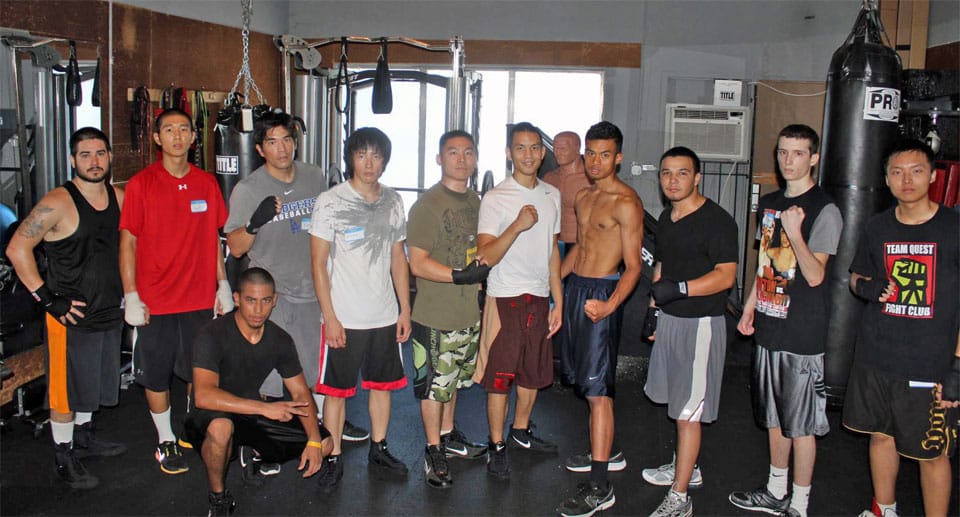
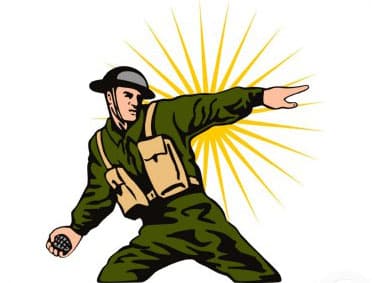

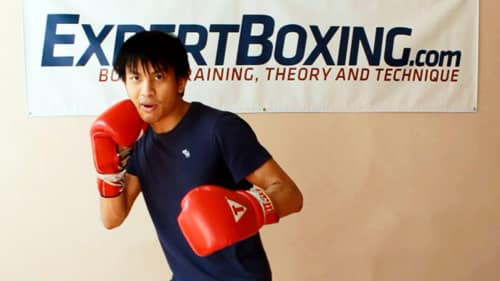

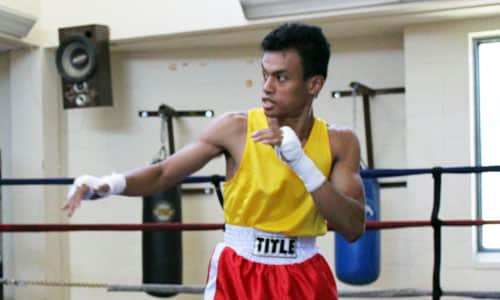
Dope ass article once again Johnny!!!
Really loved this article Johnny! The title of this article seems kinda weird but reading it showed just how useful and versatile light punches are in boxing or fighting in general.
Thanks a lot for these great articles, and keep them coming:)
Quality article man. I can’t tell you how much I appreicate all the stuff you write, it’s helped me improve so much. I’m a good level above more talented beginners than me in sparring purely from reading your blog. Many, many thanks.
i admire how this article is like the bow on two other articles you did in the past, good work johnny!
Johnny, I can’t stress enough how valuable this website is to boxers of all skill levels. So often do you manage to articulate the subtleties of the game that I believe are lacking in a lot of gym’s. Not only do I learn new tricks and tips, but you lend credence to things I discover on my own through practice. I really enjoyed this article!
Good boxer, good writer, and good coach. The writing and logic are so good that it can be enough informative even without watching the videos.
Fantastic article! Read this last week and went straight to a spar, really works! Can’t wait to practice it more and make it a big part of my game. Thanks!!
Seriously dude you are a clown and joke for blocking me on youtube for stating the facts about what you DON’T know about peek a boo style boxing. All I was telling you was to have knowledge before you speak and try to break down a subject you don’t know anything about. You let other jokers get on there and say absurd things but because I actually know what I am talking about and simply corrected you blocked me.
You are being blocked because of the language you choose to communicate with. If you find this hard to understand, I suggest you go to any boxing gym and find a boxing coach you disagree with, confront him on HIS territory and call him a clown. And see how he responds.
Good luck to you.
This article is really well done. Speed is just as important as power when it comes to fighting. Keep up the good work!
Hi jhonny! maybe this is not the section to ask you this but what do you think about this tool?
https://www.youtube.com/watch?v=_aM5pluPsTI
could it be useful to develop speed, endurance and accuracy?
thank you
Not really. You need functional, speed, endurance, and accuracy. This tool is better than nothing, but it’s not more effective than the currently existing training methods in boxing (mittwork, live sparring, bagwork.) The problem to me is that it’s not realistic of a live match. Doesn’t train your eyes to respond to human movement.
How u doing Johnny – I have a Q so please answer : since this article is about light punches – there is a light punch named BOLO PUNCH and i dont know any thing! about this punch 😀 ! – i did some search about it on google but there was nothing accurate , somone said to me its some kind of light uppercut but if thats true why its called bolo punch ?! — can u say to me what exactly is this punch and what use it has ???
THANKS A LOT JOHNNY
The bolo punch is when you swing your arm in a circle (like a bolo) before letting the fist go and hitting the guy with it. It’s more of a flashy showoff punch than a real powerful one. You can look it up on youtube.
This is brilliant. Nick Diaz uses this same technique as an mma fighter. He mixes he’s shots up very we;; and this allows him to throw a ridiculous amount of punches.
I do thaiboxing, (done some boxing as well to help with my thaiboxing..)
I like to just touch touch touch with the jab, then pull his left hand away and throw a short right hook..
Not sure if this is legal in straight boxing though?
Pulling your opponent’s glove away is definitely illegal in boxing but there have been similar tactics utilized, I’m sure. Especially in close range.
When you throw light punches do you turn your hips into them? when i turn my hips my combinations become much slower but I’ve also been told not to throw combinations with just my arms. Could it be that the first punches in a combination are light, fast, mostly arm punches and the last punch has the legs and hips behind it? thanks